The Infantry of the British Army, comprises 49 infantry battalions, from 19 regiments. Of these, 33 battalions are part of the Regular army and the remaining 16 a part of the Army Reserve. The British Army's Infantry takes on a variety of roles, including armoured, mechanised, air assault and light.
The British Army is listed according to an order of precedence for the purposes of parading. This is the order in which the various corps of the army parade, from right to left, with the unit at the extreme right being highest. Under ordinary circumstances, the Household Cavalry parades at the extreme right of the line. Militia and Army Reserve units take precedence after Regular units with the exception of The Honourable Artillery Company and The Royal Monmouthshire Royal Engineers.

The 3rd Brigade is a combined arms brigade of the Australian Army, principally made up of the 1st and 3rd Battalions of the Royal Australian Regiment. Initially raised in 1903 as part of the post-Federation Australian Army, it was removed from the order of battle in 1906 following the restructure of the field force. It was re-formed in 1914 for service during World War I, taking part in the fighting at Gallipoli and on the Western Front in Europe. During World War II the brigade was used in a defensive role before it was disbanded in 1944. It was re-raised in 1967 for service during the Vietnam War and later went on to provide the nucleus of the deployment to East Timor during the Australian-led intervention in 1999. The brigade is currently based at Lavarack Barracks in Townsville, Queensland.
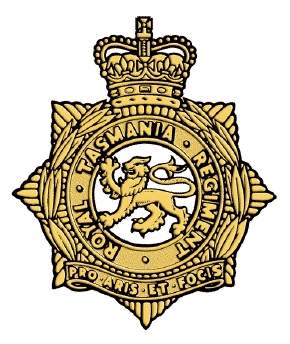
The Royal Tasmania Regiment (RTR) is a Reserve infantry regiment within the Australian Army consisting of a single battalion. Formed in 1960 following a review of military formations in Australia, the Regiment can trace its lineage back to the late 19th Century and has served Australia in a number of conflicts including the Boer War, World War I and World War II. Today it serves as a part of the Australian Army's 4th Brigade, 2nd Division.

The 1st Battalion was an infantry battalion of the Australian Army. Although its numerical name was designated during the First World War, the 1st Battalion can trace its lineage back to 1854, when a unit of the Volunteer Rifles was raised in Sydney, New South Wales. This unit has since been redesignated a number of times, but through its links with the units of the colonial NSW defence force, the battalion's history includes services in Sudan and South Africa. During the First World War, the 1st Battalion was raised for overseas service in 1914 as part of the First Australian Imperial Force. Attached to the 1st Brigade, the battalion served in Egypt initially before taking part in the fighting in Gallipoli against the Turks. Later the battalion was sent to the Western Front where it fought in the trenches in France and Belgium as part of the Australian Corps. Following the end of the war the battalion was disbanded in 1919.

The 3rd Battalion was an infantry battalion of the Australian Army. Originally raised as part of the First Australian Imperial Force for service during World War I, the battalion formed part of the 1st Brigade, attached to the 1st Division. It was formed shortly after the war broke out and was among the first Australian units to be sent overseas, arriving in Egypt in December 1914. In April 1915 the battalion participated in the Landing at Anzac Cove, coming ashore in the second and third waves. In December 1915 the 3rd Battalion was evacuated from the Gallipoli peninsula and withdrawn to Egypt again, where it took part in the defence of the Suez Canal before being sent to France to fight on the Western Front in March 1916. For the next two and a half years the unit would serve in the trenches in France and Belgium and would take part in many of the major battles fought during that time. In May 1919, following the end of the war, the battalion was disbanded and its personnel repatriated back to Australia.

The 4th Battalion was an infantry battalion of the Australian Army. Originally raised as part of the First Australian Imperial Force during the First World War, the battalion formed part of the 1st Brigade, attached to the 1st Division. During the war the battalion fought at Gallipoli and in the trenches on the Western Front, before being disbanded in 1919. In 1921, the battalion was re-raised as a militia unit and designated as the "4th Battalion ", adopting the designation of the Australian Rifles militia unit from which many of the battalion's recruits had come during the war. In 1930, the battalion was amalgamated with the 3rd Battalion and they remained linked until 1936, when they were delinked.

The 10th Battalion was an infantry battalion of the Australian Army that served as part of the all-volunteer Australian Imperial Force during World War I. Among the first units raised in Australia during the war, the battalion was recruited from South Australia in August 1914 and formed part of the 3rd Brigade, 1st Division. After basic training, the battalion embarked for Egypt where further training was undertaken until the battalion was committed to the Gallipoli campaign. During the landing at Anzac Cove, it came ashore as part of the initial covering force. Members of the 10th Battalion penetrated the furthest inland of any Australian troops during the initial fighting, before the Allied advance inland was checked. After this, the battalion helped defend the beachhead against a heavy counter-attack in May, before joining the failed August Offensive. Casualties were heavy throughout the campaign and in November 1915, the surviving members were withdrawn from the peninsula. In early 1916, the battalion was reorganised in Egypt at which time it provided a cadre staff to the newly formed 50th Battalion. It was transferred to the Western Front in March 1916, and for the next two-and-a-half years took part in trench warfare in France and Belgium until the Armistice in 1918. The last detachment of men from the 10th Battalion returned to Australia in September 1919.

The 9th Brigade is a Reserve formation of the Australian Army headquartered at Keswick Barracks in Keswick, South Australia, with elements located in New South Wales and South Australia. The brigade was first raised in 1912 in New South Wales following the introduction of the compulsory training scheme.
The 4th Regiment, Royal Australian Artillery is an artillery unit of the Australian Army. Currently it provides close artillery support to the 3rd Brigade and is based at Chau Pha Lines, Lavarack Barracks in Townsville, Queensland. The regiment was raised in its current form in 1960 and is currently re-equipping with M777A2 lightweight towed howitzers. The regiment deployed during Australia's commitment to the Vietnam War and has subsequently deployed to Singapore and East Timor.
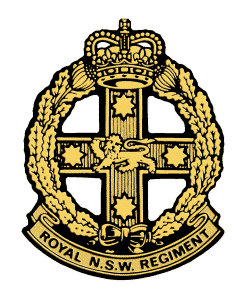
The 41st Battalion, Royal New South Wales Regiment,, is an infantry battalion of the Australian Army. An Army Reserve unit, it is one of four battalions of the Royal New South Wales Regiment and is attached to the 5th Brigade, 2nd Division. It is based in northern New South Wales, with its headquarters in Lismore and depots in a number of locations including Tweed Heads, Grafton, Kempsey, Port Macquarie and Coffs Harbour. In its present form the battalion was raised in 1965, however, it can trace its lineage back to a couple of Scottish Rifles units formed in the 1800s in Byron Bay and Maclean. It also perpetuates the battle honours and traditions of the 41st Bn AIF, that served on the Western Front during World War I.
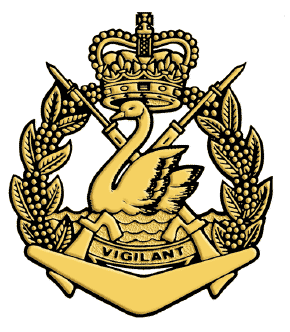
The 11th/28th Battalion, Royal Western Australia Regiment is a Reserve infantry battalion of the Australian Army. Located in Western Australia, it is one of the two battalions of the Royal Western Australia Regiment which forms the infantry component of the 13th Brigade.

The 32nd Battalion was an infantry battalion of the Australian Army. It was first raised in 1915 as part of the all-volunteer Australian Imperial Force for service during the First World War, and was initially made up of personnel from South Australia and Western Australia. The battalion served in France and Belgium in 1916–1918 before being disbanded in 1919.
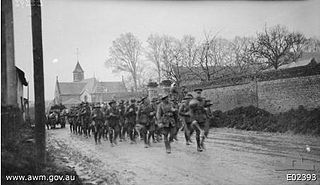
The 27th Battalion was an infantry battalion of the Australian Army. It was initially raised in 1915 as part of the all-volunteer First Australian Imperial Force for service during World War I. During the conflict, the battalion saw action briefly at Gallipoli before later fighting on the Western Front between 1916 and 1918. It was disbanded in 1919, but was re-raised in 1921 as part of the Citizens Force, which later became the "Militia". During World War II the battalion was used mainly in a garrison role until the last year of the war when it was committed to the fighting against the Japanese during the Bougainville campaign. Following the end of hostilities it was disbanded in May 1946. Between 1948 and 1965 the battalion was re-raised and disbanded a number of times before eventually becoming part of the Royal South Australia Regiment. It was disbanded for a final time in 1987, when it was amalgamated with the 10th Battalion, Royal South Australia Regiment to form the 10th/27th Battalion, Royal South Australia Regiment.
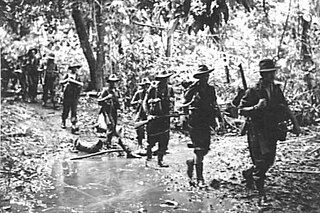
The 30th Battalion was an infantry battalion of the Australian Army. It was originally formed in 1915 during the First World War as part of the all-volunteer Australian Imperial Force (AIF) and saw service on the Western Front before being disbanded in 1919. It was re-raised in 1921 but was later amalgamated with the 51st Battalion in 1930. In 1935 the two battalions were delinked and the 30th re-raised in its own right. During the Second World War it undertook garrison duties in Australia before undertaking active service in New Guinea in 1944–1945. After the war, it was disbanded in early 1946. In 1948, the battalion was re-raised again and remained on the order of battle until 1960 when it was absorbed into the Royal New South Wales Regiment.

The 4th Military District was an administrative district of the Australian Army. During the Second World War, the 4th Military District covered all of South Australia, with its headquarters at Adelaide. Around the start of the Second World War, the 4th Military District became part of Southern Command, along with the 3rd and 6th Military Districts in Victoria and Tasmania. This required legislative changes to the Defence Act (1903), and did not come into effect until October 1939.

The 48th Battalion was an infantry battalion of the Australian Army. It was originally raised in 1916 for service during World War I and took part in the fighting in the trenches of the Western Front in France and Belgium, before being disbanded in early 1919. After the war, the battalion was re-raised as a part-time unit based initially in Victoria and later in South Australia. In 1930 it was amalgamated with the 43rd Battalion and remained so until late 1939, subsequently being linked with the 10th Battalion in 1942. The battalion did not see combat during World War II, and after the war was re-raised as an amalgamated unit, again with the 43rd Battalion, in 1952. They remained linked until 1960 when the 43rd/48th Battalion was subsumed by the Royal South Australia Regiment.
The 43rd Battalion was an Australian Army infantry unit that was originally formed during the First World War as part of the all-volunteer Australian Imperial Force. Raised in early 1916, the battalion subsequently fought in the trenches of the Western Front from late 1916 until the end of the war in November 1918. After the war, the 43rd was re-raised as a part-time unit in South Australia, serving until 1930 when it was merged with the 48th Battalion. During the Second World War, the 43rd was briefly re-raised between 1942 and 1944, but did not see action before it was disbanded. After the war, the 43rd and 48th were once again merged, existing until 1960 when they became part of the Royal South Australia Regiment.

The 44th Battalion was an infantry unit of the Australian Army. Originally formed in 1916 for overseas service during World War I, the battalion fought in the trenches along the Western Front in France and Belgium between late 1916 and 1918, before disbanding at the conclusion of hostilities. During the inter-war years, the 44th became part of the part-time Citizens Force, based in Western Australia. During World War II, it undertook garrison duties in Australia but was not deployed overseas to fight. In the post-World War II period the 44th was amalgamated with the 11th Battalion, before being subsumed into the Royal Western Australia Regiment in 1960.

The Adelaide Regiment of Volunteer Rifles was a infantry regiment of the Colony of South Australia. It was formed in 1860, as the Adelaide Regiment, following the amalgamation of a number of rifle companies. It continued to exist periodically throughout the 19th century until the Federation of Australia.

















